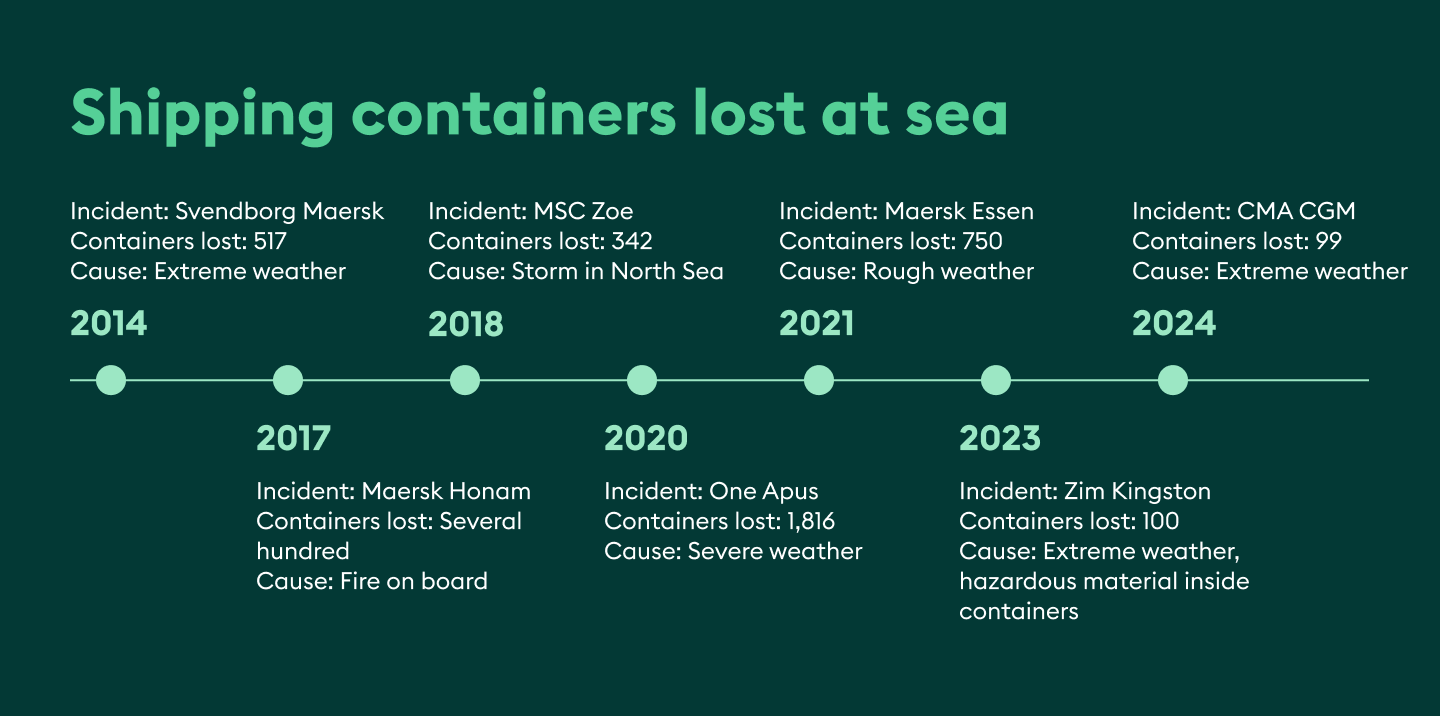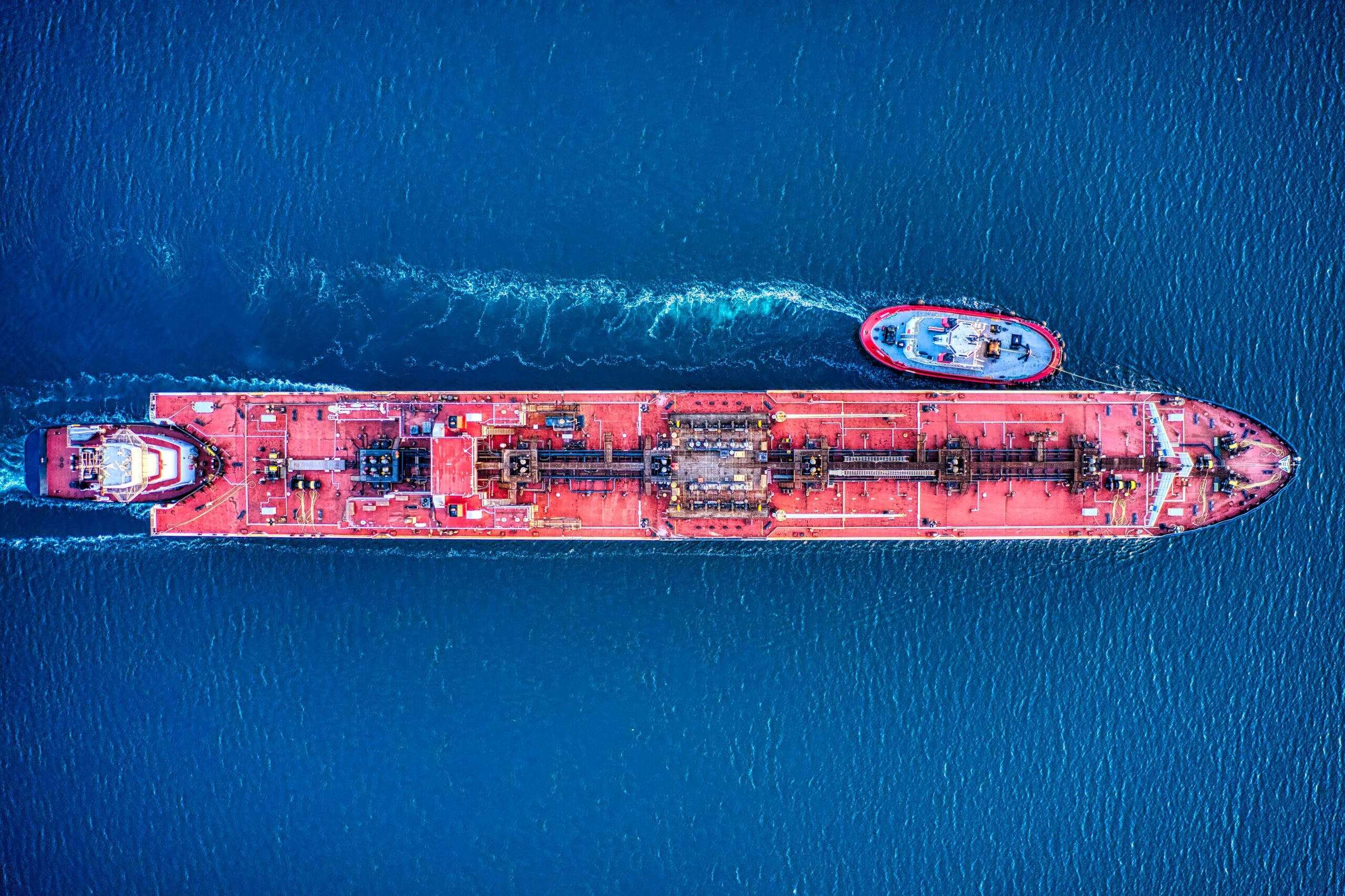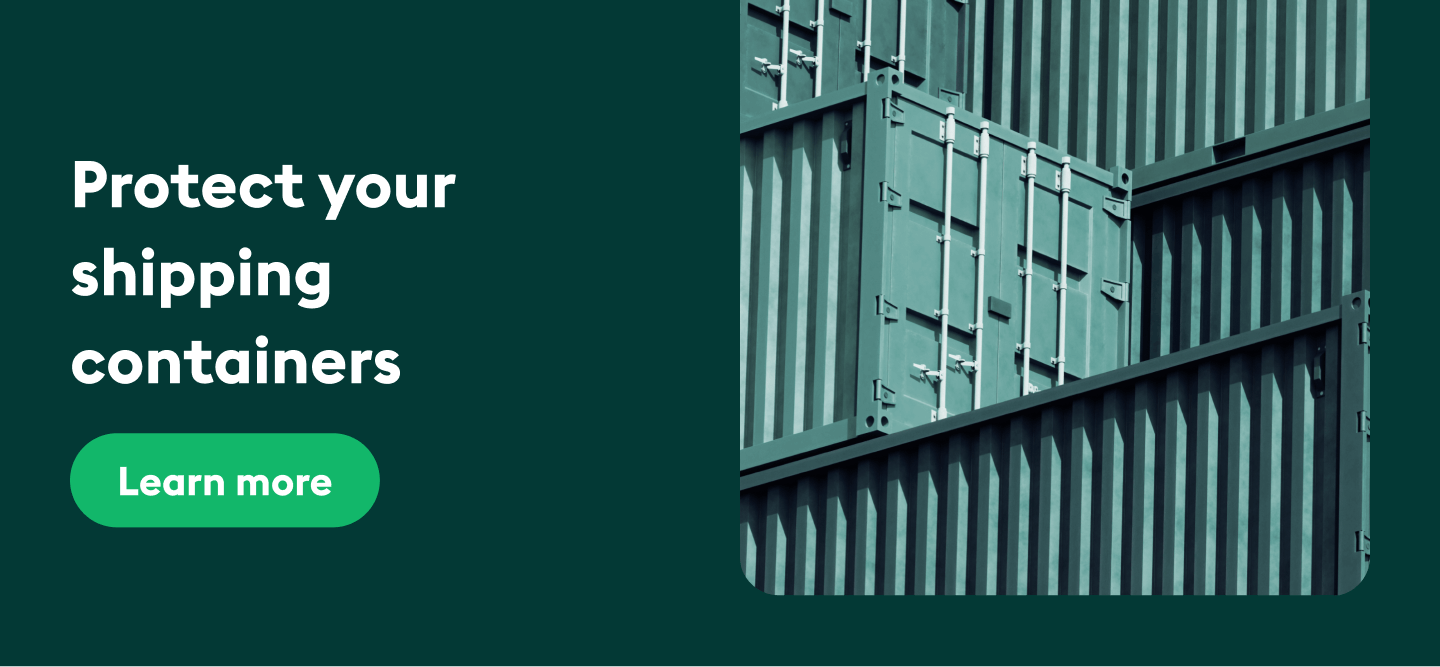Every year, between 200 and 2000 shipping containers are lost at sea, costing businesses millions in damaged goods and delays. Luckily, there are ways to protect your units and ensure your business remains profitable. Read this blog to find out more.
Losing shipping containers at sea is an expensive ordeal. And while it’s difficult to completely avoid such incidents, there are things you can do to minimize the damage to your wallet.
At Container xChange—the largest global container marketplace—we offer everything you need to secure and track your shipping containers from start to finish. With our comprehensive dashboard, you can buy the containers you need and get insurance for them.
Moreover, use our tracking service to stay informed about the whereabouts of your containers, keep partners updated, and tackle issues before they become costly delays.
We’ll tell you all about containers lost at sea and their impact on shipping operations in the following sections. Or, if you’re already aware of the impacts, you can head straight to our blog on container insurance.
How often are shipping containers lost at sea?
In 2011, the World Shipping Council (WSC) began surveying its member companies to estimate how many containers are lost at sea each year. The latest data from 2023 indicates that a total of 221 containers were lost, out of 250 million transported.
The 2023 data represents the lowest losses since the start of the survey in 2011 and a significant improvement from the previous year (2022), in which a total of 661 were lost.
Reviewing the results over fifteen years (2008-2022), the WSC estimated that, on average, 1,566 containers are lost at sea each year. In the last three years, the average is 2,301 units per year (2020-2022).
Shipping containers lost at sea 2014-2024
Here’s a quick rundown of the major incidents that have led to container losses at sea over the past 10 years.
2014: Svendborg Maersk
In 2014, Svendborg Maersk lost 517 containers after encountering adverse weather exiting the English channel. Cargo loss was primarily caused by heavy cargo rolling when conditions became more severe than anticipated.
2018: Maersk Honam
On March 6, 2018, the Maersk Honam experienced a severe fire while on route from Singapore to the Suez Canal. The cause of the fire remains unknown to this day. Several hundred containers were destroyed during this incident.
2019: MSC Zoe
The MSC Zoe container incident happened on January 2, 2019, when approximately 342 containers overboard were lost while navigating the North Sea, off the coasts of Germany and the Netherlands.
2020: ONE Apus
The ONE Apus lost 1,816 containers in a violent storm while transiting the Pacific Ocean in November 2020. The vessel, which was headed for Long Beach, turned around and headed for Japan instead.
2021: Maersk Essen
The Maersk Essen incident occurred in January 2021 while en route from China to Los Angeles. The vessel lost approximately 750 containers overboard during a severe storm in the Pacific Ocean. Heavy seas and strong winds caused the ship to roll violently.
2023: Zim Kingston
In October 2021, the Zim Kingston encountered a severe storm off the coast of British Columbia, Canada, causing 109 containers to topple overboard. Shortly afterwards, a fire broke out on the ship due to dangerous goods onboard.
2024: CMA CGM
In July this year, CMA CGM lost 99 containers off the coast of South Africa while on route from Asia to Europe, according to Seatrade Maritime. Rough weather caused a stowage collapse, leading to containers being swept overboard.
Why do containers get lost at sea?
As we can see, the majority of the incidents mentioned above were caused by adverse weather at sea. Let’s understand how weather causes containers to fall off ships, as well as looking at some other reasons for container losses during shipping.
Severe weather and storms
Storms and adverse weather may include strong winds, heavy rain, and large waves. These elements can cause vessels to destabilize. When ships roll heavily (move side to side) or are hit by strong waves, containers can shift or break loose from stacks and fall overboard, even when properly lashed and secured.
Structural failures
Inadequate lashing equipment and improperly stacked containers are common causes of structural failures. Over time, metal fatigue and poor maintenance can also cause units to slip out of place and fall into the sea.
Fires onboard
Fires can occur when hazardous materials are transported on vessels. If a fire breaks out, it may damage the ship’s structure or other containers around it.
Human error and mis-tracking containers
Human error includes poorly stacking containers, overloading a vessel, or failing to secure units adequately. Apart from this, mis-tracking and poor document management can make tracing and accounting for lost units challenging.
Technological advancements can help track containers at sea
If you feel like it’s all doom and gloom, don’t worry. Technology is constantly improving to help prevent shipping containers from getting lost at sea. Let’s learn more:
Better monitoring and reporting
Satellite systems and drones help provide real-time information on the movement of ships, in turn enabling faster identification of lost containers at sea.
Automated reporting tools mean that incidents can be communicated quickly, allowing for timely recovery efforts. Container tracking also helps to reduce financial losses for owners and shippers.
IMO regulations
In recent years, the IMO (International Maritime Organization) has implemented rules such as the Verified Gross Mass (VGM) regulation, which requires exact container weights to be disclosed before shipping.
This means more accurate container stacking and distribution on vessels is possible, which helps to prevent containers from toppling overboard during rough weather.
Blockchain technology
Blockchain technology is able to record every step of a shipping container’s journey, from the moment it’s loaded onto a ship until it arrives at its final destination. With blockchain, every player in the shipping process can access the same data. Information cannot be tampered with, preventing fraud and increasing trust between partners.
Enhanced marine forecasting and weather routing
Accurate forecasting systems provide ships with detailed, up-to-date information about the weather. This, combined with advanced weather routing software, can help vessels plan accordingly and avoid potentially dangerous conditions altogether.
How to reduce the risk of losing containers at sea
Although we can’t prevent containers from getting lost at sea (yet!), we can help you with two important things: container tracking and container insurance.
Track your units to prevent delays and issues
Monitoring your containers is an important way to keep tabs on your fleet. With xChange Tracking, you can track your units in near real-time to preempt delays or potential problems and plan accordingly.
Keep an eye on all your containers in one convenient place using our platform. You’ll receive alerts as soon as units require your attention, as well as ETAsWhat is estimated time of arrival? Estimated time of arrival, commonly known as ETA, is a frequently used term globally to denote the time of coming. In the shipping & logistics industry, it is ... More and delay warnings, so that you can make alternative arrangements as soon as they’re needed.
On your tracking dashboard, you’ll get a global overview of all of your containers. You can look up specific container numbers, locations, and partners whenever you want, in just a few clicks. What’s more, share alerts and delay warnings with your partners and customers effortlessly via the platform, in order to keep them in the loop.
Insure your units against damage and loss
If you want to insure your units against damage and potential loss at sea, we’ve got you covered with the xChange Insurance Manager. Whether you have containers under management on our platform or not, cover your units with us hassle-free. Protect your containers from the following risks:
- Containers lost at sea: If containers are lost due to adverse weather at sea, you’ll be covered.
- Impact damages and careless handling: Get paid out for dents, holes, and other damage caused by improper container handling.
- Mysterious disappearance: In the unfortunate event that your containers have vanished and your partner has stopped responding to you, you’ll avoid huge losses with our insurance coverage.
- Damages beyond repair and units bent out of shape: If your units get damaged beyond repair or seriously misshapen due to bad weather at sea or poor handling, receive the compensation you deserve.
Finally, comprehensive container insurance and tracking are right at your fingertips. All you have to do is reach out and grab it! Click the banner below to start your container-buying and journey with us right away, and start protecting your containers and your wallet immediately.
Protect your shipping containers with Container xChange
If you’re ready to have peace of mind during container journeys, here are some benefits you’ll enjoy when buying/selling and insuring containers through xChange.
Minimize risks: Protect your business and your margins by avoiding the unexpected financial difficulties that come with container damage or loss.
Cover your units in seconds: Cover your containers in just seconds—no fuss, no frills. As soon as your units are protected, you’ll receive a clear overview summary.
Get professional support: Tired of wasting time and effort managing damage claims? We assure you our processes are simple and efficient. Plus, our expert team is available 24/5 for any questions or concerns you may have.
Comprehensive cover: Whether your containers are damaged or lost, you can rest easy knowing your fleet is covered. Plus, we’ll help you get the right refund for your units.
Want to find out more? Click the banner below to chat with our expert team about how to buy containers from vetted suppliers, cover them in no time at all, and track them effortlessly with Container xChange today.
Shipping containers lost at sea: Common FAQs
How many shipping containers get lost at sea?
The latest data from 2023 indicates that a total of 221 containers were lost, out of 250 million transported. Between 2020 and 2022, average losses came in at 2,301 units per year.
How do ships avoid losing containers at sea?
Ships can avoid losing containers at sea by ensuring proper stacking and lashing of units on board, adhering to weight and height restrictions (by following IMO regulations), and making use of advanced tracking and monitoring systems.
Why do containers get lost at sea?
Severe weather and storms at sea can cause shipping vessels to destabilize, meaning that containers can slip out of place and fall off ships. If containers are poorly lashed and stacked, units are more likely to become unstable and topple.






